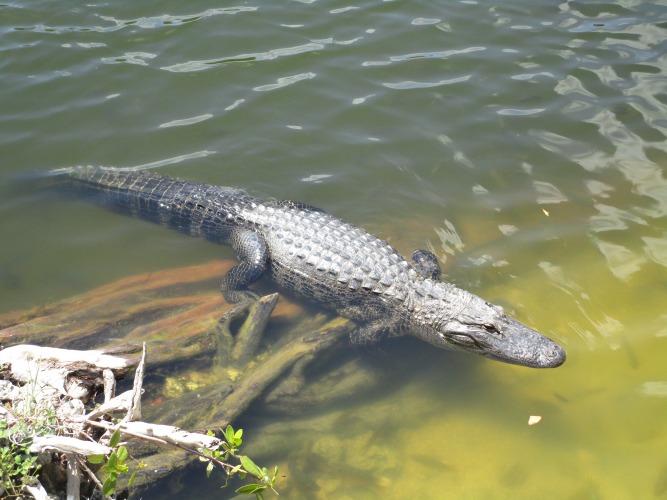Lake Conroe is found on the West Fork of the San Jacinto River in Montgomery County.
It’s a stunning marine environment for jet-skiing, boating, and fishing.
Although this lake features one of the most remarkable qualities of water bodies in the Houston area, alligator sightings have been reported.
The last relevant alligator sighting in Lake Conroe was dated May 2019.
It is, however, vital to note that the deepest parts of the lake are the significant alligator sightings.
Contents
Are There Alligators in Lake Conroe?
The area is home to many alligators.
This lake is approximately 85KM2.
Contrary to its name, Lake Conroe’s significant portion is in Montgomery County, while only a small portion is in Conroe, Texas.
Alligators are all over East Texas, down to the Louisiana line and the Gulf of Mexico.
Therefore, Lake Conroe is no exception. In this lake, alligators are only spotted once or twice a year, as sighting them is not as easy.
Designed to serve as a significant fishery, Lake Conroe was established by the Texas Parks and Wildlife (TP&W).
Additionally, this lake acts as a recreation reservoir, and locals and visitors flock there for swimming and other recreational purposes.
To date, there have been several alligator sightings in Lake Conroe.
One of the significant alligator sightings was reported on March 4th, 2004.
A KTBS helicopter flying over Lake Conroe captured a massive alligator in the water through a camera, later shot dead by game wardens.
Buffalo Bayou is known to be the deepest part of Lake Conroe.
Some years later, people spotted an alligator sunbathing in this area near the Waugh Bridge.
However, the presence of alligators does not prevent Lake Conroe’s activities from flowing.
There is no danger as long as one keeps safe to avoid the possibility of conflict with a gator.
Alligator Species in Lake Conroe
The American alligator (Alligator mississippiensis) is the common alligator species you will likely find in Lake Conroe.
Although the American alligator can tolerate brackish water, it typically loves living in freshwater.
Description
American alligators are very common in Texas, with a life span of 35 to 80 years.
A recent estimation states that there are about 400,000 to 500,000 alligators all over Texas.
These reptiles are difficult to track because they are considered an endangered species.
These alligators have lizard-like bodies with powerful jaws and muscular tails.
Researchers state that alligators had been on the verge of extinction, but they’ve made a massive comeback within the past 30 years.
With the males growing to an average length of 10 to 15 feet, female gators grow to an average length of 9.8 feet.
Both can weigh up to 1,000 pounds.
One male alligator can mate with more than ten females at a go.
The mating season runs through the middle of spring, lasting to May.
After two months, females lay 35 to 50 eggs.
The incubation period lasts 65 days when baby-alligators hatch out of the eggs.
The baby alligators are highly vulnerable to predators, so the mothers protect them until they are one year old.
These alligators reach maturity at 10 to 12 years and are about 6 feet long.
Alligators’ skin is highly valued, and humans tend to interfere with these reptiles for it.
The federal government of Texas has recently listed the American alligators as a threatened species.
This mostly comes due to their similarities with American crocodiles.
American alligators are carnivores.
These reptiles are not picky about food and are satisfied with any prey that comes their way, including humans.
They also feed on fish, mollusks, birds, and other insects.
Despite being carnivorous, they also feed on fruits.
Alligators play a significant role in the ecological niche by regulating the number of prey species in Lake Conroe.
Additionally, the dens and caves that they burrow come as a benefit to other animals around this lake.
Is It Safe to Swim in Lake Conroe?
Despite being one of the most incredible lakes in Texas, Lake Conroe also features among the deadliest lakes.
However safe this lake is, it still harbors inherent dangers, making swimming unsuitable.
Between 2010 and 2020, the Texas Parks and Wildlife Department reported 26 deaths at Lake Conroe.
These deaths were related to boating and drowning accidents.
Below are reasons why Lake Conroe is not suitable for swimming, among other dangers.
Alligator Infestation
Among the dangers of swimming in Lake Conroe is encountering an alligator.
Gators are most active from dusk to dawn.
You can go swimming when the alligators are less active to lessen the possibilities of conflict.
An alligator may interpret a water splash as the presence of a food source.
It is best to stay away from alligator-infested water bodies.
Drowning Possibilities
Between the years 2010 and 2020, about 26 drowning deaths were reported.
Fourteen deaths involved a vessel, nine involved boating DUIs, and five involved boat crashes.
However, the state records show that about 85% of these deaths could have been prevented were it not for the negligence of safety precautions.
Most people overlook safety precautions while boaters fail to undergo a safety checklist for operating the vessels. Most of these individuals lack licenses.
High Volume Boating
Lake Conroe is home to locals and visitors.
With the steady flow of visitors on weekends and summer holidays, there is an increased boating activity on the lake.
It takes very little for the collision to occur, given that so many boats are on the water.
Alternatively, drivers may not see swimmers due to a large number of boats, hence leading to accidents.
Drunkenness
Despite the strict rules that boat operators should not drive under the influence of alcohol, some of them still operate vessels while drunk.
Boating DUIs lead to unforeseen deaths of the swimmers and the vessel operators.
Hypothermia
Water temperatures in Lake Conroe fluctuate between 480F in winter and 860F in summer all year round.
Hypothermia is a typical case when the water falls below 680F.
Swimmers can easily succumb to hypothermia, especially if they are not wearing life jackets.
Interesting Alligator Facts in Lake Conroe
Over the past few years, there have been exciting facts about alligators in Lake Conroe.
While many new alligator-related stories exist, much misinformation, including myths, still exists about Lake Conroe.
Myth #1: Alligators Have Poor Eyesight
Most people around Texas believe that alligators have lousy eyesight.
This is not true.
Alligators’ eyes are positioned on both sides of their heads to give them a comprehensive and clear view.
These reptiles can spot their prey from very far away.
Myth #2: Alligators Cannot Run in a Zigzag Pattern
It is a common belief among the people of Texas that running from an alligator in a zigzag pattern will make it retreat.
The truth is that running in this pattern only shortens the distance between you and the gator, giving it a chance to attack you.

Alligators VS Crocodiles
Although crocodiles and alligators may appear similar at first glance, they are different species.
The most significant attributes differentiating these reptiles are their jaws, color, feet, and overall body size.
Alligators are pretty small as they have a U-shaped snout compared to crocodiles with V-shaped snouts.
Crocodiles measure 10 to 20 feet long with up to 2,000lbs, while alligators weigh up to 800lbs with a length of 8.2 to 12 feet.
The alligators’ feet are webbed to allow better swimming, while the crocodiles possess a jagged fringe as their feet are not webbed.
Additionally, you can easily distinguish the two from their colors.
Crocodiles are generally olive green or light brown, while alligators are dark gray or black, featuring a cream underside.
While alligators have around 80 teeth with a wide upper jaw that hides the lower teeth, crocodiles have about 66 teeth, with the upper and lower jaw roughly the same size.
With their aggressive nature, crocodiles rarely inhabit Lake Conroe.
Crocodiles are not native to Texas as they can only be found in some parts of Florida.
However, they are nearly extinct in Florida as well.
3 Safety Tips for Swimming in Alligator-Infested Water
Understanding alligator behaviors can essentially solve having negative encounters with them.
Despite these species being dangerous, you can still enjoy encountering them while swimming by following these three tips:
- Swim only in designated areas: Most swimming areas do not operate past sunset as these reptiles are most active from then to dawn. Ensure to keep 30 feet away from alligator-infested areas while swimming.
- Neither feed nor harass alligators: Offering food to alligators is dangerous, especially if you encounter them while swimming. This practice is, however, prohibited in most Texas State Parks. Feeding alligators on purpose may provoke them to associate you with food.
- Engage the park wardens: If you spot an alligator while swimming, be sure to engage the park wardens, especially if it comes toward you.
Summary
While Lake Conroe is one of the best attraction sites in Texas, it is characterized by the presence of alligators.
However, alligators should not call for alarm as they are spotted once or twice a year.
As long as you observe all the safety precautions, you will likely not have any negative encounters with alligators.
Most importantly, note that alligators will attack when agitated.
Frequently Asked Questions
Are alligators more dangerous than crocodiles?
Since alligators are not fussy eaters, they rarely chase after prey unless they are cornered.
Crocodiles are known to be aggressive and hence more dangerous.
Since crocodiles are bigger than alligators, they have a stronger bite and usually chase after prey more often.
Alligators may retreat when approached by humans and only act up when provoked.
Do Alligators Hibernate?
Alligators temporarily shut down through brumation rather than hibernating.
This process is similar to hibernation in that it slows down the metabolism, making the reptiles lethargic.
Alligators can be in brumation for a few months before they resume normal.
How is Lake Conroe in Terms of Safety?
Although Lake Conroe is a significant attraction for thousands of visitors and locals, it surprisingly features among the deadliest lakes in Texas.
With over 20 deaths within a time frame of ten years, visitors should take precautions seriously.
This fact, however, should not make you not doubt the lake’s serenity.












Lake Conroe is a beautiful lake for recreational activities such as boating and fishing, but it’s important to be aware of the potential dangers, including alligators.